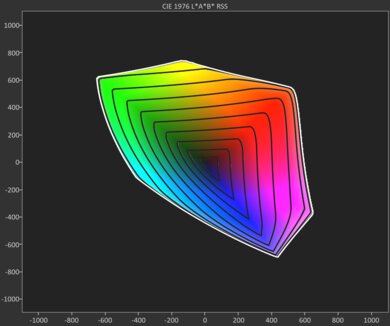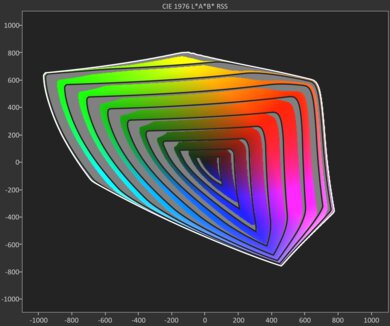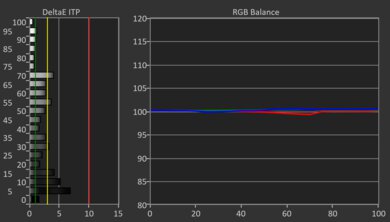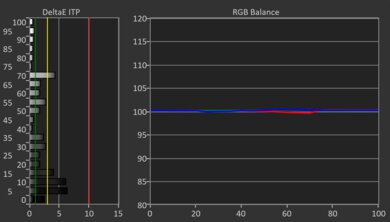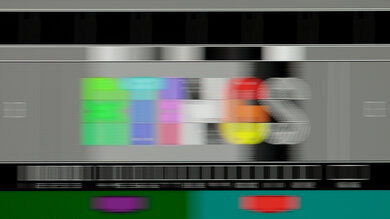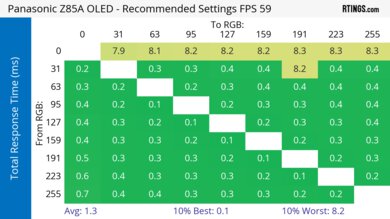After a few years of not releasing TVs in the US, Panasonic made the decision to release three models in 2024. This includes the Mini-LED Panasonic W95A, the MLA OLED Panasonic Z95A OLED, and this TV, the Panasonic Z85A OLED. Unlike the flagship MLA OLED, this model uses a standard WOLED panel, so it's a direct competitor to TVs like the LG C4 OLED and the Sony BRAVIA 8 OLED.
The TV is loaded with modern features like HDMI 2.1 bandwidth on two ports, 4k @ 120Hz, and support for all VRR technologies. It also supports Dolby Vision and HDR10+, but it doesn't passthrough DTS audio formats. The TV uses Panasonic's HCX Pro AI Processor MK II, which can analyze the content you're watching to adjust colors, clarity, contrast, and sound automatically. It runs the Fire TV OS, has support for Alexa and AirPlay, and the TV has a built-in 50W 2.1 channel speaker system. We bought and tested the 65-inch model, but it's also available in a 55-inch option.
Our Verdict
The Panasonic Z85A is very good for mixed usage. It's great for use in reference conditions like a home theater since it has perfect blacks, vibrant colors, and incredible accuracy. The TV is also a solid option for gaming, thanks to its modern gaming features. However, it does lack some brightness in HDR to fully display bright highlights, which holds back some of the impact HDR content should have. If you like to watch content with a group of friends, its wide viewing angle gives a consistent image no matter where you're sitting. Unfortunately, the TV isn't bright enough and doesn't have the reflection handling needed for a bright room, so it's best suited for a moderately lit environment.
-
Near-infinite contrast ratio for perfect blacks with no blooming around bright highlights.
-
Incredibly wide viewing angle for a consistent image from the sides.
-
Colors are vibrant, lifelike, bright, and accurate.
-
Direct reflections are distracting.
-
Lacks the SDR brightness needed to overcome glare in a bright room.
The Panasonic Z85A is great to use in a home theater. You get those perfect black levels OLEDs are known for, so despite the TV only having decent HDR brightness, HDR content is still impactful, and highlights stand out against darker backgrounds. Furthermore, the brightness of HDR content stays true to the content creator's intent. It also provides vibrant colors in SDR and HDR, so colors pop regardless of the source, but there's some banding in color gradients. The TV has outstanding upscaling and good low-quality content smoothing, which gives you a mostly clean-looking image when watching low-resolution and low-quality content. Unfortunately, due to the TV's nearly instantaneous response time, there's noticeable stutter in movies and TV shows.
-
Near-infinite contrast ratio for perfect blacks with no blooming around bright highlights.
-
Colors are vibrant, lifelike, bright, and accurate.
-
Does an outstanding job upscaling and a good job cleaning up low-quality content.
-
Noticeable stutter due to the TV's fast response time.
-
Doesn't support DTS audio passthrough.
The Panasonic Z85A is adequate for a bright room. Blacks remain deep, and colors remain well-saturated in ambient lighting, but the TV is only bright enough to fight glare in moderately lit rooms. The TV struggles to reduce the intensity of direct reflections, so it's not a good choice if you have wall lights, lamps, or a window opposite the screen.
-
Blacks remain deep and colors stay vibrant in a room with ambient lighting.
-
Direct reflections are distracting.
-
Lacks the SDR brightness needed to overcome glare in a bright room.
The Panasonic Z85A is decent for watching sports. It has great overall image processing that helps upscale low-resolution broadcasts, and low bitrate content is cleaned up well by its good low-quality content smoothing. You also get vibrant and punchy colors so your favorite team's jersey doesn't look muted. Unfortunately, the TV isn't very bright in SDR and struggles with direct reflections, so it's not the best option for watching the game on a sunny afternoon with the curtains open. On the other hand, there's barely any dirty screen effect in the center of the screen thanks to its very good uniformity, and motion is smooth due to its fast response time. Finally, its wide viewing angle means the image doesn't degrade when viewed from the sides of the screen, making it a solid choice for large group settings.
-
Incredibly wide viewing angle for a consistent image from the sides.
-
Nearly instantaneous pixel transitions for no noticeable blur behind fast motion.
-
Colors are vibrant, lifelike, bright, and accurate.
-
Does an outstanding job upscaling and a good job cleaning up low-quality content.
-
Direct reflections are distracting.
-
Lacks the SDR brightness needed to overcome glare in a bright room.
The Panasonic Z85A is great for gaming. It has nearly instantaneous pixel transitions and low input lag, which ensures a responsive gaming experience, and you get all three flavors of VRR to drastically help reduce screen-tearing. Its HDR brightness is only decent, so highlights aren't super bright in HDR games, but those games are still impactful thanks to the TV's perfect black levels. You also get vibrant colors that pop out, so your favorite games don't look dull and muted. The TV has HDMI 2.1 bandwidth on two ports for up to 4k @ 120Hz, which makes it a solid option to pair with your modern console.
-
Nearly instantaneous pixel transitions for no noticeable blur behind fast motion.
-
Colors are vibrant, lifelike, bright, and accurate.
-
Only two HDMI 2.1 ports, one of which is also the eARC port.
The Panasonic Z85A has alright brightness overall. Highlights in HDR content stand out well enough, but the TV is too dim to fully display highlights in content mastered at 1000 nits. The TV's SDR brightness is acceptable for a moderately lit room, but it's too dim to use in a brightly lit environment.
-
Lacks the SDR brightness needed to overcome glare in a bright room.
Being that the Panasonic Z85A is an OLED, it has outstanding black levels. Blacks are deep and inky when viewed in a dark room, with no blooming around bright highlights.
-
Near-infinite contrast ratio for perfect blacks with no blooming around bright highlights.
The Panasonic Z85A has impressive colors. This is an incredibly accurate TV in both SDR and HDR, so the content creator's intent is well respected without needing calibration. The TV has solid color volume overall, so colors are vibrant and lifelike, but it does struggle more with displaying very light colors, especially compared to QD-OLEDs.
-
Colors are vibrant, lifelike, bright, and accurate.
Note: We're in the process of improving our tests related to image processing, but this score should give you a general idea of how a TV performs overall with its image processing capabilities.
The Panasonic Z85A has great image processing overall. It does an outstanding job upscaling low-resolution content so it doesn't look too soft. The TV's low-quality content smoothing is good, but there are still some noticeable artifacts in low-bitrate streams. The brightness of HDR content is very accurate, so it stays true to the content creator's intent. However, there's noticeable banding in grays and bright greens.
-
Does an outstanding job upscaling and a good job cleaning up low-quality content.
-
Exceptional HDR brightness accuracy.
The Panasonic Z85A has excellent responsiveness while in the True Game mode. It supports VRR for a nearly tear-free experience, and its nearly instantaneous pixel transitions means fast motion is sharp. The TV's input lag is very low across the board, so gaming feels responsive.
-
Nearly instantaneous pixel transitions for no noticeable blur behind fast motion.
-
Only two HDMI 2.1 ports, one of which is also the eARC port.
We're in the process of fixing the way we evaluate a TV's overall motion handling. This section is currently broken, and the score isn't indicative of how well a TV handles motion overall.
- 8.1 Mixed Usage
- 8.4 Home Theater
- 6.7 Bright Room
- 7.3 Sports
- 8.5 Gaming
Performance Usages
- 6.7 Brightness
- 10 Black Level
- 8.2 Color
- 8.4 Processing (In Development)
- 8.9 Game Mode Responsiveness
- 7.7 Motion Handling (Broken)
Changelog
-
Updated Jul 08, 2025:
Mentioned the newly reviewed Philips 974 Series OLED in the Low-Quality Content Smoothing section.
- Updated May 08, 2025: Converted to Test Bench 2.0.1. We did this to fix an issue with our scoring in the Supported Resolutions section, since TVs with a refresh rate higher than 144Hz were being penalized for not supporting 144Hz.
-
Updated Mar 26, 2025:
We confirmed the TV supports ATSC 3.0 after firmware update RS8112/2491 and updated the results and text in the Input Specifications section of the review to reflect that.
-
Updated Mar 26, 2025:
We wrote text for the new tests and rewrote text throughout the review after updating pre-existing tests and scores for Test Bench 2.0.
- Updated Mar 26, 2025: We converted the review to Test Bench 2.0. With this new methodology, we've added new tests to expand the scope of our testing, adjusted our scoring to better align with current market conditions, and added performance usages that group related tests together to give more insight into specific aspects of a TV's performance. You can find a full list of changes in the TV 2.0 changelog.
Check Price
Differences Between Sizes And Variants
We bought and tested the 65-inch Panasonic Z85A (65Z85AP), and these results are also valid for the 55-inch model (55Z85AP). There are no known variants of the TV, so our results should be valid for all regions, but the inputs vary depending on regional requirements for tuners.
| Size | Model Code |
| 55" | TV-55Z85AP |
| 65" | TV-65Z85AP |
Our unit was manufactured in July 2024, as seen on our product's label.
Popular TVs Comparisons
The Panasonic Z85A is an excellent TV overall, but it doesn't outperform similar OLED models from other brands. It competes most with a TV like the LG C4 OLED, but the C4 is the better TV overall and is available in a much wider range of sizes. The Panasonic delivers very similar picture quality as the cheaper LG B4 OLED, but the B4 is slightly better overall, making the Panasonic a hard TV to recommend over LG's OLED offerings.
For more options, check out our recommendations for the best OLED TVs, the best gaming TVs, and the best TVs for watching movies.
The LG C4 OLED is better than the Panasonic Z85A OLED in some ways. The LG is the brighter TV overall and has better reflection handling, so it overcomes more glare in a bright room and delivers a more impactful HDR experience. The LG also does a better job smoothing out artifacts in low bitrate content, and it supports 144Hz, which is great for PC gamers. On the other hand, the Panasonic has slightly better upscaling capabilities.
In most ways, the Samsung S90D OLED (QD-OLED) is better than the Panasonic Z85A OLED. The Samsung is brighter in HDR and displays a wider range of colors with almost no banding in color gradients, so it delivers a more impactful HDR experience. The Samsung also supports 144Hz, which is great for PC gamers, and it performs better in a bright room thanks to its better reflection handling and SDR brightness. On the other hand, Panasonic has better overall image processing.
The Panasonic Z85A OLED and the Panasonic Z95A OLED are very similar overall, but the Z95A is a good step up. The Z95A is considerably brighter in HDR. While this difference isn't noticeable with the majority of HDR content, bright scenes, and small specular highlights are considerably brighter on the Z95A. The Z95A also offers a higher 144Hz refresh rate for gamers. While this doesn't currently matter for console gamers, it's a definite advantage for PC gamers.
The LG B4 OLED and the Panasonic Z85A OLED are evenly matched, but there are some minor differences. The LG is brighter in SDR, so it handles more glare in a room with the lights on. The LG also has a bit less banding in color gradients and does a slightly better job cleaning up artifacts in low bitrate content. However, the Panasonic has slightly better upscaling capabilities.
The Panasonic Z85A OLED and the Sony BRAVIA 8 OLED are very similar overall, with only some minor differences. The Sony is brighter in SDR and has the edge with reflection handling, so it’s better suited for use in a bright room. The Sony also has better low-quality content smoothing, so it removes more artifacts from low-bitrate content, and it has a bit less banding in color gradients. However, the Panasonic gets a bit brighter overall in HDR, so it makes some highlights stand out a bit more in HDR content. The Panasonic is also the more accurate TV overall and has a slight edge when it comes to upscaling.
Video

We buy and test dozens of TVs yearly, taking an objective, data-driven approach to deliver results you can trust. Our testing process is complex, with hundreds of individual tests that take over a week to complete. Most of our tests are done with specially designed test patterns that mimic real content, but we also use the same sources you have at home to ensure our results match the real-world experience. We use two main tools for our testing: a Colorimetry Research CR-100 colorimeter and a CR-250 spectroradiometer.
Test Results
The TV has decent HDR brightness, making highlights stand out during darker scenes. Combined with its remarkable contrast, this TV provides a solid HDR viewing experience. Unfortunately, due to its aggressive Automatic Brightness Limiter (ABL), large, bright scenes are significantly dimmer than smaller, specular highlights.
These measurements are after calibrating the HDR white point with the following settings:
- HDR Picture Mode: Professional 1
- Ambient Sensor: Off
- Luminance Level: 100
- Contrast: 100
- Peak Luminance: High
- Gamma: 2.2
- EOTF Type: Auto
- HDR Tone Map: Normal
- Color Temperature: Warm 2
There's no noticeable difference with HDR brightness when the TV is set into True Game.
These measurements are after calibrating the HDR white point with the following settings:
- HDR Picture Mode: True Game
- Ambient Sensor: Off
- Luminance Level: 100
- Contrast: 100
- Peak Luminance: High
- Gamma: 2.2
- EOTF Type: Auto
- HDR Tone Map: Clipping
- Clipping Threshold: 2000
- Color Temperature: Warm 2
The TV has acceptable SDR brightness and overcomes glare in a moderately lit room. Unfortunately, it's not bright enough to overcome glare in a well-lit room.
These measurements are after calibration with the following settings:
- Picture Mode: Professional 1
- Ambient Sensor: Off
- Luminance Level: 100
- Contrast: 90
- Peak Luminance: High
- Gamma: 2.2
- Color Temperature: Warm 2
If you'd like a Panasonic model with better SDR brightness, take a look at the Panasonic W95A.
It's an OLED with no backlight, so its self-lit pixels give it the same performance as an option with perfect local dimming and no zone transitions. We still film the zone transition video on the TV so you can see how it compares to a TV with local dimming.
The Samsung Z85A has great color volume. Its coverage of the DCI-P3 color space is outstanding overall, but it does struggle more with very light colors. Unfortunately, its coverage of the wider BT.2020 color space is more limited.
| Volume ΔE³ | DCI-P3 Coverage | BT.2020 Coverage |
|---|---|---|
| L10 | 93.79% | 63.69% |
| L20 | 97.09% | 66.97% |
| L30 | 98.01% | 68.62% |
| L40 | 97.61% | 69.96% |
| L50 | 96.80% | 70.12% |
| L60 | 95.39% | 68.34% |
| L70 | 93.10% | 60.04% |
| L80 | 93.76% | 57.91% |
| L90 | 91.33% | 56.25% |
| L100 | 82.70% | 53.89% |
| Total | 94.57% | 63.69% |
The TV has good color volume. It displays dark, saturated colors very well, and its ability to display bright whites is outstanding. Unfortunately, as with all WOLED panels, bright colors are a bit washed out, as the TV relies on the bright white subpixel to achieve the brightest highlights, which dilutes color purity.
The TV has remarkable pre-calibration SDR accuracy. Its white balance and color accuracy are nearly perfect, with very minor errors that aren't visible with real content. Its color temperature is a bit warmer than the target of 6,500K, but it's barely noticeable. Gamma is close to 2.2, but some bright scenes are a bit too bright.
The TV has exceptional accuracy after calibration. Any minor errors in white balance, color temperature, and gamma are gone, and colors are even more accurate than before.
See our full calibration settings.
The Panasonic Z85 has fantastic HDR pre-calibration accuracy. There's a bit too much blue in darker shades of gray and not enough red in mid-grays, which makes the TV's color temperature cooler than 6,500K. Color accuracy is superb overall, with only some minor inaccuracies throughout.
Calibrating the TV in HDR does very little to improve its accuracy. White balance is a bit better now, and although its color temperature is a bit closer to 6,500K, it's still slightly too cool. The accuracy of colors has barely shifted at all, and the TV is still very accurate, with very minor mapping errors.
The TV has exceptional PQ EOTF tracking. It follows the curve almost perfectly until it approaches its maximum brightness. With content mastered at 600 or 1000 nits, there is a gradual roll-off near the TV's peak brightness to maintain some detail in bright highlights. With content mastered at 4000 nits, the roll-off happens much sooner to preserve detail in very bright highlights.
The Panasonic Z85 has good low-quality content smoothing. It does an excellent job at preserving details, but it's only decent at actually smoothing out the image, so there is still some noticeable macro-blocking in dark scenes. Still, you end up with a much cleaner image than you do on a cheaper WOLED such as the Philips 974 Series OLED.
The TV does an outstanding job with upscaling low-resolution content like DVDs, standard definition cable channels, and lower-resolution streams. Details are well-defined and clear enough, but very fine details and small hard-coded text are a bit hard to make out.
Sharpness processing was calibrated with no over-sharpening for low-resolution content with the following settings:
- Sharpness: 30
- Resolution Remaster: Max
The TV has good HDR native gradient handling. There's some noticeable banding in grays and bright greens, but all other colors have minimal banding or no banding at all.
This TV has very low input lag when set into True Game, which ensures a very responsive gaming experience.
The Panasonic Z85 supports all common resolutions up to 4k @ 120Hz on two of its four HDMI ports. Chroma 4:4:4 signals are displayed properly with most supported resolutions when the TV's 'HDMI Setting' is set to Pure Direct, which is important for text clarity.
The Panasonic Z85 supports FreeSync, HDMI Forum VRR, and G-SYNC, ensuring a nearly tear-free gaming experience from any VRR-enabled source. It works well across a wide refresh rate range and supports sources with Low-Frame-Compensation (LFC), which ensures your games remain nearly tear-free even when your frame rate drops very low.
The Panasonic Z85 is fully compatible with everything the PS5 offers, like 1440p @ 120Hz and 4k @ 120Hz, as well as HDMI Forum VRR. It also supports Auto Low Latency Mode, so you don't have to worry about switching to True Game to get the lowest input lag.
The Panasonic Z85 is fully compatible with everything the Xbox Series X|S offers, including 1440p @ 120Hz, 4k @ 120Hz, HDMI Forum VRR, FreeSync Premium Pro, and Dolby Vision gaming. It also supports Auto Low Latency Mode, so you don't have to worry about switching to True Game to get the lowest input lag.
Unfortunately, due to the TV's nearly instantaneous pixel response time, there's stutter with low frame rate content, which is most noticeable during slow panning shots.
The Panasonic Z85 TV automatically removes judder from 24Hz sources and the internal apps. To remove judder from 60p and 60i sources, like a cable box, you must enable the Accurate IFC setting. Unfortunately, movies and TV shows aren't judder-free when BFI is enabled because the BFI feature only flickers at 60Hz.
This TV doesn't have a traditional backlight and doesn't use pulse-width modulation (PWM) to dim each pixel, but it's not completely flicker-free. There's a slight dip in brightness that corresponds to the TV's refresh rate. This differs from the PWM flicker on TVs with LED backlights and occurs on every OLED we've tested. It's not noticeable, and most people won't be bothered by this, but it can still bother people who are extra sensitive to flicker.
It does exhibit flicker-like behavior in low-luminance sections of the screen that resembles pulse amplitude modulation (PAM). This means that bright sections of the screen are flicker-free, but darker sections have very minor flicker present. Fortunately, this isn't noticeable with real content.
The Panasonic Z85 has an optional black frame insertion (BFI) feature that reduces the appearance of persistence blur caused by the TV's nearly instantaneous response time. However, it can only insert black frames at a 60Hz refresh rate, and it doesn't work very well, so the image is blurry, and there's some ghosting present.
This TV has an optional motion interpolation feature to improve the clarity of motion. It does a good job at smoothing out slower scenes, with only some minor artifacts present. In faster-moving scenes, it can't keep up, and there are distracting artifacts, image duplication, and haloing.
The Panasonic Z85 has mediocre direct reflection handling. It doesn't do the best job reducing the intensity of direct reflections, so glare from lamps or windows opposite the screen is distracting.
The Panasonic Z85 has exceptional black levels in a bright room. Black levels are barely raised in a room with ambient lighting, and they remain deep and punchy.
The TV has good perceived color volume in ambient lighting. Colors shown at all levels of luminance are still vibrant and saturated in a bright room since they only lose a small amount of saturation from ambient sources of light.
The TV's incredibly wide viewing angle remains mostly consistent from almost any angle, but there is some color shifting and a very slight green tint at more aggressive angles. Still, it's a fantastic choice for watching TV in a group setting.
The TV uses a WOLED panel with a RWBG pixel structure where all four pixels are never lit at the same time. Due to its subpixel layout, it has minor issues with displaying text on Windows since ClearType isn't well optimized to non-RGB subpixel layouts, but most users won't be bothered by this.
The white subpixel does an excellent job helping the TV display bright whites, but it dilutes the color purity of greens and reds.
The Panasonic Z85 has HDMI 2.1 bandwidth on HDMI ports 1 and 2, with both supporting up to 4k @ 120Hz. Unfortunately, the HDMI 2 port is also the eARC port, so you lose a high bandwidth port when you plug a soundbar into the TV. The TV supports both Dolby Vision and HDR10+. ATSC 3.0 support was added with a firmware update (RS8112/2491) in early 2025.
The TV supports eARC, which lets you pass high-quality, uncompressed audio to a compatible receiver or soundbar through an HDMI cable. Unfortunately, it doesn't support DTS audio formats commonly used on Blu-rays.
The back section that houses the inputs is quite thick and made of plastic. When facing the front, the inputs are located on the left side of the TV, but they're easily accessible even when the TV is wall-mounted. There are clips on the back to help with cable management.
The Panasonic Z85A OLED TV has outstanding build quality. With the exception of the back section that houses the inputs, the TV is made entirely of aluminum, which gives it a premium feel. There's some minor flexing near the VESA mounting points, but this is typical and doesn't cause any issues. There are no issues with build quality, but the TV emits a slight buzzing noise.
The TV runs the Fire TV OS, which is smooth and easy to use. Unfortunately, a bug prevents certain settings, like motion interpolation, from working despite being turned on. To fix this, you must enter the 'Home' menu and then return to the input or internal app you're using.
The remote is almost identical to the ones included with other TVs that use the Fire TV OS, with quick access buttons for the most popular streaming services. You can use the built-in microphone to switch inputs, change apps, search within apps, and ask for the weather and time. Unfortunately, you can't use voice commands to change settings.
The Panasonic Z85 has a mediocre frequency response. Like most TVs, it barely produces any bass, but the speakers do get quite loud. The sound is well-balanced at moderate volume levels, making dialogue easy to understand. Unfortunately, the sound becomes unbalanced near and at maximum volume.
Comments
Panasonic Z85A OLED: Main Discussion
Let us know why you want us to review the product here, or encourage others to vote for this product.
- 21010
The 55 inch is 799 on Amazon right now.
In anyone’s experience for ps5 gaming how customizable are the game mode settings? Is it just what’s on the “game bar” and that’s it?
Or is it more like other brands where you can still adjust other settings
Update: Mentioned the newly reviewed Philips 974 Series OLED in the Low-Quality Content Smoothing section.
- 21010
I am looking into getting this tv to replace LG B6(barely used low hours). Comparing on Rtings shows me B6 beats this tv although methodology used is v1 vs v2. Can you tell me if B6 is really superior?
You can’t compare the scores between the two TVs since the B6 was tested on an old test bench. The Z85A is the better TV. It’s brighter, has better colors, and superior image processing. The Z85A also has a ton of gaming features that the B6 doesn’t have, like HDMI 2.1, VRR, and 120Hz.
- 21010
I am looking into getting this tv to replace LG B6(barely used low hours). Comparing on Rtings shows me B6 beats this tv although methodology used is v1 vs v2. Can you tell me if B6 is really superior?
- 21010
Anyone have any settings they would like to share? I like the dynamic picture setting the best cause it’s the brightest setting, but I am wondering if it’s possible to tweak the normal picture preset to match the dynamic picture setting?
Update: Converted to Test Bench 2.0.1. We did this to fix an issue with our scoring in the Supported Resolutions section, since TVs with a refresh rate higher than 144Hz were being penalized for not supporting 144Hz.












